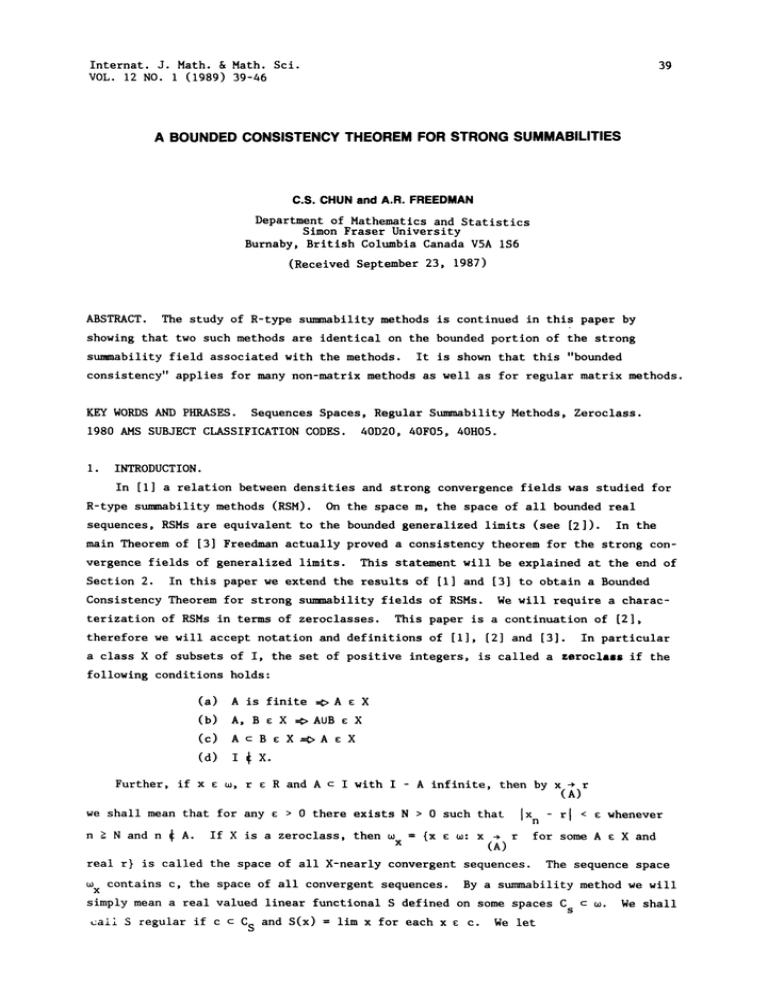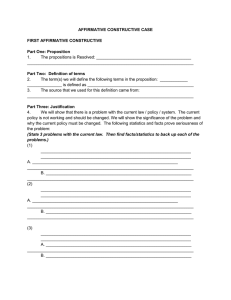Document 10438028
advertisement

Internat. J. Math. & Math. Sci.
(1989) 39-46
39
VOL. 12 NO.
A BOUNDED CONSISTENCY THEOREM FOR STRONG SUMMABILITIES
C.S. CHUN and A.R. FREEDMAN
Department of Mathematics and Statistics
Simon Fraser University
Burnaby, British Columbia Canada V5A IS6
(Received September 23, 1987)
ABSTRACT.
The study of R-type summability methods is continued in this paper by
showing that two such methods are identical on the bounded portion of the strong
summability field associated with the methods. It is shown that this "bounded
consistency" applies for many non-matrix methods as well as for regular matrix methods.
KEY WORDS AND PHRASES.
Sequences Spaces, Regular Summability Methods, Zeroclass.
40D20, 40F05, 40H05.
1980 AMS SUBJECT CLASSIFICATION CODES.
i.
INTRODUCTION.
In [I] a relation between densities and strong convergence fields was studied for
R-type summability methods (RSM). On the space m, the space of all bounded real
sequences, RSMs are equivalent to the bounded generalized limits (see [2]). In the
main Theorem of [3] Freedman actually proved a consistency theorem for the strong convergence fields of generalized limits. This statement will be explained at the end of
Section 2. In this paper we extend the results of [I] and [3] to obtain a Bounded
Consistency Theorem for strong summability fields of RSMs.
terization of RSMs in terms of zeroclasses.
We will require a charac-
This paper is a continuation of [2],
therefore we will accept notation and definitions of [i], [2] and [3].
In particular
a class X of subsets of I, the set of positive integers, is called a zeroclaI$ if the
following conditions holds:
(a)
(b)
(c)
Further if x
e
A is finite
A e X
A, B X > AUB e X
A c B X A X
,
r e R and A c I with
I
A infinite, then by x
N
we shall mean that for any e > 0 there exists
n >_- N and n
#
A.
If X is a zeroclass, then
x
> 0 such that
{x e : x
n
r
(A)
the space of all convergent sequences.
rl
CS
and S(x)
e whenever
The sequence space
By a summability method we will
x
simply mean a real valued linear functional S defined on some spaces C
call S regular if c c
r
for some A e X and
real r} is called the space of all X-nearly convergent sequences.
contains c
(A)
lim x for each x e c.
We let
s
c
.
We shall
C.S. CHUN AND A.R. FREEDIkN
40
Cs
ICsl :
S(x)
CS:
{x e
:
{x
0},
II Cs}
and
ICsl
=
:
{
o
lCsl
some real r}.
ICsI
.
The set
is called the strong summability field associated with the method S.
A method S will be called an RSM when S is regular and
(i.e.,
[ is
solid)
If S is an RSM, then
are subspaces of C ([1] Proposition 4.9).
S
c I: S(X
is an RSM, then X
is a zeroclass where
{A
If S:
0}
A)
S
XA is the
talcs I =ICs
ICsI ICS I
ICs
CsR
characteristic function of A.
For any x e
We shall say that X is the zeroclass related to S.
S
and e > 0, let
N(x)
Then the class
{Ne(x):
{y e : sup
{{x i
yi{:
i= 1,2,3
<
x e m, e > O} forms a base for the topology
}
T
on
.
For any
RSM
S:(Cs,Tm)
2.
BOUNDED CONSISTENCY ON STRONG CONVERGENCE FIELDS.
In this section we first develop a theory of strong convergence fields with the
R, S is continuous ([2]).
help of the zeroclass concept
DEFINITION 2.1. For any zeroclass X we denote
Vx
V
O
X
PROOF.
e X}
For any zeroclass X,
(2 I)
is a linear space of sequences.
X
V
Ixil}
O
{x e : x-r e VX for some r e R}.
X
PROPOSITION 2.1.
V
m: For any a > 0, {i :a <
{x
is a subspace of V
(2 2)
X
Suppose that x,y
Vx,rl,r 2
R with x-r.,y-r.iz e V
x
.< alz
Ixi+Yi- (rl+r2)
o.
For each i and
for any a > 0,
[xi-ri[-<
/2 and
lyi-rzl
<. c.
Thus
{i:lxi+Yi
(rl+r2)
By the definition of
{i:
lYi-r2[
>
that x+y’; V
x.
=/2}
>
a}
c
{i:
Ixi-rll
>
a/2}
Vx
and the properties of
zeroclasses
e X and {i:
>
[xi+Y i (rl+r2)l
If k e R, then for any
> 0,
=}
E
lYi-r21
{i:
Ixi-rll
U {i:
X.
Consequently
/2}.
>
/2}
we get
U
BOUNDED CONSISTENCY THEOREM FOR STRONG SUMMABILITIES
41
,
{i:
Therefore for any a
a<[kxl-kr I[}
a<Ikxl-krll
0, {i:
0,
if k
X, which implies kx e
e
Vx.
Hence
Vx
is a
linear space of sequences.
(2.2) is obvious.
PROPOSITION 2.2
Tx(x)_
defined by
..IVxI
V
o
Vx.
Then
Further, X is related to T
x
PROOF.
r when x-r e
Tx
is
X
R be the function from
,I
In this proof we will write Tx as T for convenience.
Vx, T(x)=rl and T(x)=r 2,
(x-rl) (x-r2) (r2-rl)e
If x e
well defined.
is a linear space,
fact that for any a > 0
{i: a<
and {i: a <
[(r2-r l)e i[}
Suppose that x, y e
Vx
Vx to R
an RSM with domain Vx,
’IVxl Vx and
Tx: Vx
For any zeroclass X, let
is a linear space,
l(r2-rl)eil}
Vx
(x+y)-(rl+r2)
T(x+y)fT(x)+T(y) and T(kx)ffikT(x).
and
I
Vx
e
ox
so that x-r I, x-r
2
X, it follows that
and T(x)=r
First, we show T is
Vx where
!.
(I,I,I,
e
<a
then, since
Vx
From the
I=2-=iI
rl=r 2.
Vx
T(y)nr 2.
O
Then x-r I, y-r e
2
o
and kx-kr e
for any k e R.
Vx
Since
Therefore
Hence T is a linear functional.
Next we have
{x: for any a
VX
Suppose that x
0, {i:
a<[yi[}
c
Proposition i).
For any A
c
XA
e V
v}
VxO*
Ivl (R)<.>-Ivl.
lvl
<e,
and
{i: a <
ll
lyl
[xil
e
(i.e.,
X and so {ix
lyll -<
a
X}
II
<lyil
o
e X.
any i).
Thus for any
Thus we have y
Hence T is an RSM.
I,
o
x
a<[Xi[
-: II
{i: a <
Hence
Ivl ,
O, {i:
>
A,
if 0 < a < I,
,
if l.<e.
A(i)}
if an only if A
X.
Thus T and X are related.
IVx [
42
C.S. CHUN AND A.R. FREEDMAN
.
Note that these results can be written in the following notation:
v
Ivl Iczl, Ivl = Icl
cT,
For any zeroclass X, V is closed with respect to the topological
x
PROPOSITION 2.3.
space (,T,).
PROOF. Supposed that x e
suPi
n
Ix-xil<i/n
,
n
xU
and choose {xn} c V such that Ux
x
n
(xn)
e R. Since x converges to x as
Suppose that
Vx
show that lim r exists.
n n
Irn -x[
<
Clearly
lrn
If
> c,
rml
i:([rn
{i:
-<
rml
e and
{rn}
{+/-:(I=n
c)12
x
[xi-=[
<
<-
e)/2
<
I=
e)12
x
<
1}
Irn
so that
I)
IX,
i:(irn rml_e)/2<lxi_rmlm
u (:
x
and
a contradiction.
Hence
[rn-rml
sequence of real numbers.
Now we show that x e V
irn -r[
e
c
We
+
+
rml
Ix i rml
<
is a Cauchy
x-xn| </3 and
rml
{i:(Ir
then
.
N e I such that n,m Z NIxn-xm|m
I,
Suppose that n,m N. For each i
> 0, there exists
we have, for any
c
rn
Tx
(n > I).
For any a >
/3.
Let lim r
r e R.
n
0, we choose N
I such that n
>
N
==>
For any i e I
Ixi- xl + [xin-rn[ + I=.-1
<
2c/3 +
[x- rn[.
Therefore
n)--
Since T(x
r
n
we have {i:
=/3
<
.Ix i
r
n I}
Hence x e Vx and so V
x
X.
e
is
closed.
For any zeroclass X, V o is a closed subset of (,T)
x
o
PROOF. T )__
R
is an RSM and so it is continuous. Thus T
V
x
x
x
is closed subset of (V T). Since V is also closed in (,T) V o is closed in
x
X
X
PROPOSITION 2.4.
-I(0)
:(Vx,T
(,T,).
PROPOSITION 2.5.
For any zeroclass X,
with respect to the topology
PROOF.
of x
()r,_
U{1,2,3
Suppose that x
x’
x
Since
x
(where
x
denotes the closure of
T).
r e R and A e X with
we have, for any a-0, there exist N e
N}.
V
and {1,2,3
x(A) r.
Then by the definition
I such that {i:
N}e X, we have {i:
a<lxi-rl}
a<lxi-rl}e X.
Hence
BOUNDED CONSISTENCY THEOREM FOR STRONG SUMMABILITIES
x eV
Therefore
X
V
c
X
Since V
X
is closed, we have gX c VX
X
For each n, let {i:
Suppose that xeVx and T(x)=r.
ne
43
Then A
n
I/n<Ixi-rl}=An
X.
by
Let us define x
r
if
i e I-A
if
i
n
n
x
XA)
Obviously,
i
n
r and A e X, thus x e
n
An.
x
Since
we get
|x
n
-x[=
& I/n.
x by ux
Replacing
Ir-xil
if
i I-A
n
0
if
iA,
n
--.
mx
It follows that x
o
V
by V
x
x
o
Hence -=V
x x"
and r by 0 we obtain
x=Vx where Ux
PROPOSITION 2.6.
For any zeroclass X,
PROPOSITION 2.7.
(see (i] Proposition 4.10).
o
{xm:
AX
x()0}.
If the zeroclass X is related to the
RSM S, then
o
u
n
x
ICs
’I c Vx
c
m
(2.3) Let x
PROOF.
and
0.
x()
Since
A
x
m
(2.4)
have same value on
o
x-XI_A c o c I%1 ([i]
t. o
lCs I ,a o
Further
.
XAE
ICsl
<
I%1
ixil
(2.4) Obviously,
m
x
n
and so
m
Since x e m
Proposition 4.9).
, , o. x
x{i:
CsI.
(2.5)
Then there exists a set A
nm.
x
X, we have
E
(2.3)
v=
I%1
S and T
o
X{i:
<
ixil
( o <e>)nm
x
c
Thus x
c
I such that A
and S is an RSM,
x-xA + x.xI_ A
X and
x’XA
ICs I
ICs I.
Ilt
I%1 equivalently {i:
(ICs I ( <e>)R m Icsln m.
<
Ix+/-l}x.
also,
ICsl ICsl <e> Vx (<e> Vx.
(2.5) Let lCsl. Then there exists re Rsuch thatx-relCslC CS so that S(x-r)--0
or S(x)=r. By (2.3), x-r _V o. Therefore T (x)=r.
x
x
C.S. CHUN AND A.R. FREEDHAN
PROPOSITION 2.8.
If X
V
O
x
1
and X
V
x
c
I
Vxl
then we. have
o
(2.6)
2
(2 7)
(2.8)
XeVxl.
(2.6) Suppose that
a<Ixil}eX2
Then for any a>0, {i:
eVx2.
or x
c Vx o.
Then we have x-reVx
r.
X2,
c
1
Txl
Therefore, for any a>0, {i:
Tx (x)
I
are zeroclasses with X
Vx2
c
Tx2
PROOF.
2
Thus
a<Ixil} e XlC X2.
For (2.7) and (2.8) let xe
o
V
x-rE
x
2
2
and so x e Vx
VxI
(x)=
and T
x
2
and
I
r=Tx (x).
2
PROPOSITION 2.9. (Bounded Consistency Theorem on Strong Convergence Fields). Let
R be an RSM related with
R be an RSM related with the zeroclass X1 and
SI:CsI
$2:Cs2
X.
the zeroclass
Suppose that X1
ICSll
X and
2
[Cs2[
fl m c
CSln
m c
Cs2
Then we have:
(2.9)
fl m,
ICsl n ICe21 n
$1( ICs11 n
s21(ICs1 n
(2.91
Ixlcs n
ICs1 n
(?.10)
m,
m
m).
m)
o
If x e
PROOF.
(Proposition 2.7) and
m, then
TXI(II)
the previous proposition
=
2n
n
x
Ix]
Since x
0
ICs2l n x2n
n
in
(m,T.).
e
CS 2
m.
Since S
fl m c
Tx2(X).
Tx (x)
I1
0.
o
Vx
0
II CSlO
Since
o
x= m2n
mcV
s(ll)
m,
0,
CS, S2(II)
is an
RSM, S
Vx2 Tx2(xn)=s2(xn
Hence we have
).
n
T
x
(xn)
2
ICe2 n
m sch that
c
=lim
n
I.
ICs2
(2.9),
]CsI[Nm=([CsI[)<e>) ([Cs2[@<e>)fl
S2(xn)
S (x).
2
Therefore x e
(2.10) By
Tx2[[ CS
[fl
2
m
[Cs2[flm.
and
s211 Cs In
mc
(2.11) By Proposition 2.7 (2.5),
m.
TXl II Cl In
TxI[VI Tx2[VI
Sill Csl In
By Proposition 2.8, we have
By
S2(xn) s2(lxl).
Ix[ e o Vx thus
VxI 2
On the other hand
O=Tx2(X)=lim
i, defined
Thus
is continuous.
2
Vx,,
m and by Proposition 2.7
Thus we can find a sequence {xn} in
2
I1
By (2. I0) and the
45
BOUNDED CONSISTENCY THEORI FOR STRONG SUMMABILITIES
fact that
f m c
CS1
COROLLARY I.
C
CSI CS2
S
Let
we have the result
Vx1
R and
$1:Cs1
and with same related zeroclass X.
sl<Ics 1 I m) sl<ics 1
and
Then we have
ICSllam ICs21m
n m).
Let F be the collection of all RSHs which are related to a fixed zerois a member of F and for any RSH S:C R in F, S and T have the same
x
s
x
REMARK.
class X.
R be RSMs defined on the same domain
$2:Cs2
Then T
values on the bounded strong convergence field associated with S.
Finally we look at RSHs on m.
PROPOSITION 2.10.
ICs lffiVx
Let S:C R be an RSH and let X=X
Suppose that C s tim. Then
s
s
for
any
S(x)ffiTx(X)
By Proposition 2.7, we have
m. Let x V rim. Since
xm
PROOF.
V
X
xl%l.
0m and
is the closure of
to x in
(,T(R))
(,T).
Thus
which means
c
IC
S
which converges
0
ICsl and S(x)ffir. Since s(xn)ffirn and S is
,Ixn-rnl*Ix-r in (,Z). Note that xm. Thus
is also in m, which is the domain of S.
s<l-l)=0,
x
n}
Suppose that x -rn e
rnr in R.
ClCslC Vx
we can find a sequence {x
n
continuous we have
Ix-rl
X
in
Since S is continuous and
xIC s I"
In the main Theorem of [3], Freedman proved (in the terminology of this paper)
the following:
TttEORI.
S
2
on m with
is a zeroclass, then x e
If
c
Xsl
Suppose that
S2(x
Xs2 Sl(x
c
Si:mR, Xi=l,2)
V m if and only if for any two RSNs S 1,
satisfy the hypothesi of Proposition 2.9, we show
that the above Theorem implies that the conclusion of Proposition 2.9 also holds for
S 1, S
3.
2.
If x e
ICSl
then x e
VXl
It is clear that
m.
Sl(X)=S2(x)
since X
1
c
X2
RSMs WITH A RELATED ULTRAZEROCLASS.
For a regular matrix A, we define
for any x E C
A The ordinary Bounded
In [2] we studied RSMs induced from matrices.
the linear functional
fA: CAR by fA(x) llmnAx
Consistency Theorem {BCT) (see, e.g. [4]) says that for any regular matrices A,B with
C
A
m c
CB, fA(x)ffifB(x
for any x e C
A
m.
We can easily see that the BCT for strong convergence fields (Proposition 9) is
included in the ordinary BCT for matrices when the RSMs are induced from regular
matrices.
Therefore we would llke to find examples of summabilities such that the
bounded consistency in the strong convergence fields of these summabilltles is not
implied by the matrix BCT.
An ultrazeroclass on I is a zeroclass X such that there is no
zeroclass on I which is strictly finer than X.
DEFINITION 3.1.
C.S. CHUN AND A.R. FREEDMAN
46
I,
PROPOSITION 3.1.
Let X be an ultrazeroclass on I. Then for any A2
AX or I-AX.
Then F is an ultrafilter. Thus for any AE2
AEF or
{AE21:I-AEX}.
PROOF. Let F
I,
I-AF.
PROPOSITION 3.2.
PROOF.
equivalently,
AVx
It follows that
(,T(R)),
m
O
X is an ultrazeroclass if and only if mcV
Suppose that X is an ultrazeroclass.
that is
Since V
V
A
m c V
(I_A)Vx,
or
X
AeVx
or
Then for any A2
AmX or I-AEX,
I-AeVx-
is linear space, m
X
I,
c
0
V
X
Since
V
X
is closed in
X
A21
AX
Suppose that X is not an ultrazeroclass, then there exists
such that
and
Assume that
Then there exists reR such that {i:<lA(1)-rl}
for
X
x.
I-AX.
XAeV
any e>0.
{i:I/2<IXA(1)-rl} I-AX.
{i:I/2<IXA(i)-rl}ffiAX.
If r=l, then
If r=0, then
r#{0,1},
If
then
This is a contradiction.
PROPOSITION 3.3.
matrix
A such that
PROOF.
fA
Hence
e
XA
m-Vx
If X is an ultrazeroclass then there does not exist a regular
N m
C N m.
is an RSM and
IVxl
A
Since X is an ultrazeroclass, m c
the other hand, for any regular matrix A, m- C
Vx and thus IVxl
N m
Vx
m
m.
On
A
It follows from the above and Proposition 2.9 that the value of any RSM, S, on its
bounded strong convergence field is determined by any ultrazeroclass containing the
zeroclass related to S.
REFERENCES
FREEDMAN, A.R. and SEMBER, J.J.
Densities and Summability, Pacific J. Math., 95
(1981), 293-305.
2.
CHUN, C.S. and FREEDMAN, A.R.
(To appear).
3.
FREEDMAN, A.R. Generalized limits and sequence spaces, Bull. London Math. Soc., 1_/3
(1981), 224-228.
RUCKLE, W.H. The bounded consistency theorem, Amer. Math. Monthly 8_6 (1979),
4.
566-571.
Theorems and Examples for R-type Summability Methods







